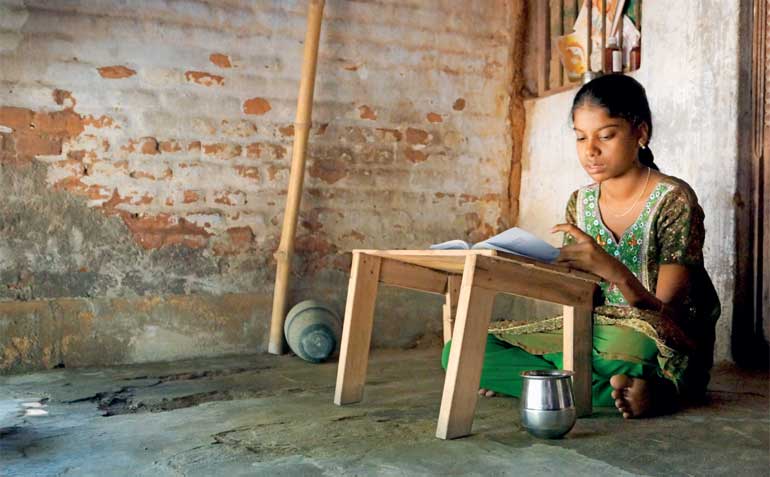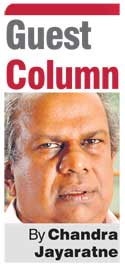Sunday Mar 09, 2025
Sunday Mar 09, 2025
Tuesday, 23 August 2016 00:01 - - {{hitsCtrl.values.hits}}
It is nearly 70 years since independence. Sri Lanka has been governed by many green, blue, blue intertwined with red governments, and now by a green and blue Government. The constitutions have changed to a Republican framework dropping all links with the former colonial rulers and the British crown. The economic policies enforced over this period have reflected links to capitalism, market, socialism, mixed, middle path and now social market.
Have any of these governance regimes and policy frameworks addressed the needs and aspirations of those at the bottom of the pyramid? Despite statistics, Central Bank and Census data, glossy publications, international presentations, policy statements, budget speeches, media communications and leadership pronouncements in Parliament; and publicly before and after elections, have the bottom segment of society been effectively touched?
Despite published GDP per capita numbers, enhancing household incomes, acceptable gini-coefficients, better regional distribution of incomes, improving numbers on poverty statistics, reducing unemployment, and high level achievements in meeting Millennium Development Goals, the answer appears to be a definite “No”.
The above conclusion is drawn by following the findings supported by recorded evidence in TV pictures, derived under the Capital Maharajah News 1st ‘Gammadda – Geying Geta 2016’ report, prepared in collaboration with the University of Peradeniya. This report has been prepared by visiting 738 villages in the country covering all districts and identifying the pivotal issues, hidden below the surface, confronted by the communities in the respective areas.
 The common thread that appears to run through these segments of society, equally across the island, appears to be that their needs and aspirations have not been recognised and prioritised by the State, due to the villagers being powerless and voiceless; and being unfocussed by all levels of persons in governance (village, pradeshiya, local government and district level). The only focused attention appears to emerge closer to elections, where promises and commitments are freely given; but never honoured post elections
The common thread that appears to run through these segments of society, equally across the island, appears to be that their needs and aspirations have not been recognised and prioritised by the State, due to the villagers being powerless and voiceless; and being unfocussed by all levels of persons in governance (village, pradeshiya, local government and district level). The only focused attention appears to emerge closer to elections, where promises and commitments are freely given; but never honoured post elections
The three main issues identified related to;
Thereafter a host of other key issues emerged in areas linked to lack of acceptable housing, human –animal conflict, education and schools, transportation, health land ownership challenges, consequential impact of war and natural disasters, environmental pollution and irrigation.
The common thread that appears to run through these segments of society, equally across the island, appears to be that their needs and aspirations have not been recognised and prioritised by the State, due to the villagers being powerless and voiceless; and being unfocussed by all levels of persons in governance (village, pradeshiya, local government and district level). The only focused attention appears to emerge closer to elections, where promises and commitments are freely given; but never honoured post elections.
It appears from news reports that the Gammadda Report and its findings have been duly communicated to the authorities in governance at the Centre, but their response actions have not been forthcoming. From news reports it appears that only the President has reacted positively to the findings and come out openly in support of programmes delivering the needs and aspirations of these segments at the bottom of the pyramid. This has led to the News First Group organising a collective business and civil society initiatives to address some of the pressing issues as a social responsibility initiative.
The unique finding which appears to have emerged from ‘Gammedda Project’ is that the provision of most of these basic needs required financial allocations of Rs. 5 million or less per village. If the average per village requirement to meet the basic needs and aspiration of these villagers is estimated at Rs 2.5 million per village, the total outlay for the 768 villages will be Rs. 1,920 million. In comparison the Daily FT of 9 June noted that “Moving a supplementary estimate in Parliament on Tuesday Government sought approval for Rs. 1,175.5 million to purchase 32 cars for 30 Ministers, State Ministers, and Deputy Ministers.” – See more at: http://www.ft.lk/article/546987/Govt--denies-Rs--1-17-b-vehicle-budget-excessive#sthash.N5cbv2uZ.dpuf
Regrettably some of the leading powers in governance appear to have even taken a hostile and critical view of the News 1st initiative, calling it “political”, and “playing politics”. They appear to feel that the media’s role is limited only to exposing the plight of those at the bottom of the pyramid; and the media institutions should not extend its mandate to taking publicly, the role reserved to governments in dealing with the findings, as thought best by the Government.
These persons in governance and their coterie of advisors appear to be firmly of the view that socioeconomic rights should not also be made a justiciable fundamental rights embodied within the Constitution. Their fears are based on the likely beyond capacity consequential costs, the likely judicial intervention in a purely political and governance arena decision making and above all the likely unmanageable public expectation set at a highly raised bar.
It must be recognised that there are cogent arguments supporting both for and against the embodiment of socioeconomic rights as a justiciable right within a constitution – A well-balanced reference is found in the Institute for Democracy and Electoral Assistance (International IDEA) publication titled ‘Social and Economic Rights,’ which begin with a quote by Julie McDowall, Scottish author and social activist reading, “But it’s hard to stand on your own two feet when your bones are softened with rickets and you’re wheezing with asthma from the black blots of dampness on the spongy bedroom wall.” http://www.constitutionnet.org/files/social_and_economic_rights_0.pdf
However, in a third world democracy with a powerless, voiceless and socio-economically neglected segments at the bottom of the pyramid, there may be no other choice but make sociocultural rights a justiciable fundamental right, in order at least to flag in the open, their basic needs and aspirations in a prioritisation of resource allocations of the nation.
How else in a local context after 70 years of independence can those at the bottom of the pyramid bring out their basic needs to stand alongside the other demands for allocations made by undemocratically governed party hierarchy thinking and decision making driven political processes, which end up placing their own priorities before a legislature supposed to represent the sovereign people of the country?
For instance, as examples, how can those at the bottom of the pyramid seek budgetary allocations in meeting their basic needs, including;
 schools attended by low income households);
schools attended by low income households);
Whereas governing political leaders strive to advance their pet projects with significant national resource allocations for;
If the Constitutional amendments embed socioeconomic rights as a part of fundamental rights, despite the negatives outlined herein before, the plight of those powerless and voiceless persons at the bottom of the pyramid and their basic needs and aspirations will have avenues to be surfaced, be focused in the minds of the political leaders and the Executive and their conscience pricked, when critical decisions on national resource allocations are made and thereafter adopted by the legislature.
In terms of the global initiative of Sustainable Development by 2030, Sri Lanka is required to have in place an agenda of action for people, planet and prosperity with goals and targets which stimulate action over the years in areas of critical importance for humanity and the planet:
People
•To end poverty and hunger, in all their forms and dimensions, and to ensure that all human beings can fulfil their potential in dignity and equality and in a healthy environment.
Planet
•To protect the planet from degradation, including through sustainable consumption and production, sustainably managing its natural resources and taking urgent action on climate change, so that it can support the needs of the present and future generations.
Prosperity
•To ensure that all human beings can enjoy prosperous and fulfilling lives and that economic, social and technological progress occurs in harmony with nature.
Peace
•To foster peaceful, just and inclusive societies which are free from fear and violence.
Partnership
•To mobilise the means required to implement this agenda through a revitalised Global Partnership for Sustainable Development, based on a spirit of strengthened global solidarity, focused in particular on the needs of the poorest and most vulnerable and with the participation of all countries, all stakeholders and all people.
It is therefore essential that the proposed Constitutional Reforms, devolve basic decision making power to the village communities and such devolvement are supported by compulsory resource allocation commitments, with decision making on the priority and projects for such resource spends being vested in the relevant communities.
In the above context, it is recommended that the proposed Constitutional Reforms include articles to convey that the ‘Gram Raj’ concept has been firmly embedded within the new Constitution, and that these provisions will ‘empower and enthrone common citizens of society’ and will effectively bring them within the decision making governance framework of each Grama Sevaka Division.
In furtherance of this empowerment, the Constitution must compel the Finance Commission to ensure that 5% of the Capital Expenditure voted in any budget year or an allocation for each Grama Sevaka division of not less than Rs. 5 million, whichever is higher is allotted by the annual budget, as reserved spend for village development. The investment priority and relevant projects covering this spend must be determined by the Grama Sevaka Division communities, by majority consensus.
These funds will be allocated to the relevant Provincial Councils and the Chief Minister and the Chief Secretary of the Province should be jointly held accountable for effective deployment of funds at Gramasevaka Division level. The Chief Secretary, as the Chief Accounting Officer, should be required to submit annually a report to the Parliament of the effective deployment of funds, the description of projects, how implemented and setting out what positive outcomes accrued to the village communities.
If there are 15,000 Grama Sewaka divisions in the country, the funds outlay required for this provision will be a minimum of Rs. 75 billion annually. The total capital expenditure voted in 2016 was Rs. 1,274 billion. This allocation then converts to 5.9% of the voted capital expenditure.
Discover Kapruka, the leading online shopping platform in Sri Lanka, where you can conveniently send Gifts and Flowers to your loved ones for any event including Valentine ’s Day. Explore a wide range of popular Shopping Categories on Kapruka, including Toys, Groceries, Electronics, Birthday Cakes, Fruits, Chocolates, Flower Bouquets, Clothing, Watches, Lingerie, Gift Sets and Jewellery. Also if you’re interested in selling with Kapruka, Partner Central by Kapruka is the best solution to start with. Moreover, through Kapruka Global Shop, you can also enjoy the convenience of purchasing products from renowned platforms like Amazon and eBay and have them delivered to Sri Lanka.
Discover Kapruka, the leading online shopping platform in Sri Lanka, where you can conveniently send Gifts and Flowers to your loved ones for any event including Valentine ’s Day. Explore a wide range of popular Shopping Categories on Kapruka, including Toys, Groceries, Electronics, Birthday Cakes, Fruits, Chocolates, Flower Bouquets, Clothing, Watches, Lingerie, Gift Sets and Jewellery. Also if you’re interested in selling with Kapruka, Partner Central by Kapruka is the best solution to start with. Moreover, through Kapruka Global Shop, you can also enjoy the convenience of purchasing products from renowned platforms like Amazon and eBay and have them delivered to Sri Lanka.